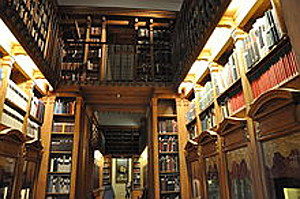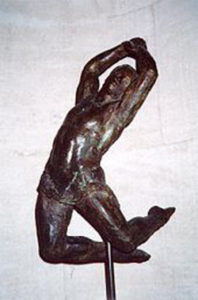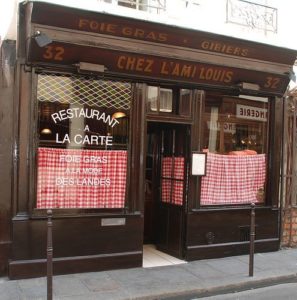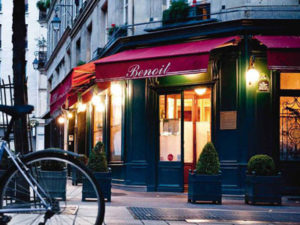Eila Hiltunen’s Sibelius Monument in Sibelius Park, Helsinki — Wikipedia
When I think of our thirteen years in Paris, what comes back to me more than anything else is my stepfather Arne’s fairly frequent visits form Sweden. My visit to Helsinki when Arne had a very serious heart attack is part of the story about my stepfather who has played such an important part in my life, and not just for my love of theater.
Arne’s visits were always accompanied by theater, opera and good restaurants. If we just stayed home we most likely had something very special for dinner since both Arne and John were good chefs — and gourmets. Arne cooked his own version of sweetbreads one time in Paris at rue Jean-Marie Jégo and I still remember that he put a bit of cayenne pepper on top. I am not very fond of cayenne pepper but it was done discretely and his culinary feat was very much appreciated.
We very soon concluded that Arne preferred to go to a restaurant of his own choosing. So rather than going to Chez Allard (two stars at one time, later one star) in the 6ème arrondissement, we let Arne suggest restaurants that had been recommended to him. In one case I believe it was Arne’s good friend from his childhood, Lars Schmidt, Ingrid Bergman’s last husband, had recommended. Lars Schmidt at that time lived in a château south of Paris. Ingrid had then moved to an island that she owned close to Fjällbacka, Bohuslän on the west coast of Sweden. Lasse, as Arne always referred to him by his Swedish nickname, owned a couple of theaters in Paris, and he always gave Arne tickets for the three of us to the Théâtre Montparnasse in rue de la Gaîté, where we went several times when Arne was in Paris. It was usually good, and I remember a performance with the excellent actress Annie Girardot in the role of “Madame Marguerite” by Roberto Athayde, a one-person show. This kind of show might seem risky, but Annie Girardot carried it off with bravura. This was apparently already in 1974 and possibly Arne’s first visit with us in Paris.
The performance was a tour de force by this excellent actress, all alone for a couple of hours on stage playing a school mistress in front of her 6th grade class. “”Mais, cette “Leçon” va être complètement baroque: tour à tour absurde, tragique, cynique, comique.” 1 Annie Girardot was splendid, a very memorable evening for the three of us, even though Arne didn’t understand much of her tempestuous flood of French words, and I don’t suppose John and I got all of it either.
___________________
Now, Arne’s friend, Lars Schmidt, was most likely also responsible for what must have been one of the topmost culinary experiences in Paris during all those years. The restaurant was an old-style restaurant in the 3rd arrondissement, Chez l’Ami Louis, at 32, rue du Vertbois, close to la Place de la République. It was the most extraordinary Paris restaurant visit I can remember. So it was most likely thanks to “Lasse” Schmidt that we found our way to this historic restaurant in the heart of old Paris, the quartier of the Arts et Métiers.
Arne was the host and he outdid himself in a way I will never forget. We had ordered a lamb roast that was supposed to be one of their favorite culinary masterpieces. Arne ordered a Bourgogne vieux to go with the lamb. When he was offered to taste it, he shook his head and said No, this was not the wine he wanted to go with this excellent lamb roast. He asked what would be the really good Bourgogne vieux and the sommelier recommended a presumably very expensive wine. Arne had never been very spendthrift, but he wanted this evening to be just very special and the wine to be perfect. We were ready to eat and I tasted this very special old Burgundy wine. I closed my eyes and sighed from sheer delight. I had never tasted a wine like this. I said so to my very dear stepfather and he agreed. It was perfect. The lamb was perfect and everything was like heaven.
As we finished our superb meal, Louis himself came into the dining room to greet his customers and of course he stopped by and chatted at some length when he found some regular customers. This is a wonderful feature of the best old restaurants in France. Once the main work is done with in the kitchen domain, the owner and head chef himself comes out and walks around the dining room, chatting with everybody and making sure that everything has been perfect.
Our very good friend Jean-Max, a genuine bourgeois Parisian of the old school (and who is also the president of the association DEVA Europe), told us the other day that l’Ami Louis is one of those old Paris gourmet restaurants in the quartiers Ars et Métiers and le Marais that are the most genuine to be found in terms of old gastronomic palaces. In fact, far from being a ‘palace’, like la Coupole in Montparnasse 2 , l’Ami Louis is a rather small, intimate and very Parisian old restaurant. It started with Louis himself coming to Paris from the provinces, like the chefs of many other high-standard Paris restaurants in those old quartiers that form a periphery around les Halles, which, alas, is no more. Those were once called “the belly of Paris” – “le ventre de Paris” (après Zola) 3 This brief history of the old Parisian restaurants in les quartiers “Arts et métiers” and “le Marais” is entirely thanks to the story Jean-Max told us about it. He was so pleased that we knew “Chez l’Ami Louis”.
This extraordinary evening Chez l‘Ami Louis took place in the early eighties, after many other pleasant dinners with Arne, in restaurants or at home.
However, on the negative side, I remember a dinner at ‘Chez Allard’ – in the 6e arrondissement, in the quartier St Germain des Prés – when we had especially in advance ordered suckling wild boar for Arne and myself, and we were expecting a culinary feast. We were served pork chops. I am surprised that I didn’t tell them to take it back, but somehow I didn’t. However, we never went back to Allard after that extreme disappointment.
At another top restaurant, Chez Benoît, close to la Place du Châtelet in the 4th arrondissement and behind Le Théâtre Sara-Bernhardt (now Théâtre de la Ville) we have noticed something of the same thing. However, as far as the food goes there is nothing but the highest praise for this very chic restuarant. Chez Benoît is another jewel in the area bordering on les Halles, southeast of the former Halles and close to the Seine. John found out about this exceptional restaurant after the Computing Center 4 was invited to a luxury dinner at this gourmet restaurant by the Control Data Corporation (who supplied the Center with their hardware). The few times we were there, we always ordered in advance lamb roast stuffed generously with veal kidneys.
Parismarais.com says “There is no place a more Parisian bistro than Benoît. The only bistro in Paris to have a Michelin star, this restaurant located in the heart of Paris near Les Halles and the Marais is a true champion of the tradition.” As far as the Michelin stars are concerned, Parismarais.com, however, is wrong, since there is a site on the Internet that says “The 15 Best Places with Michelin Stars in Paris”. Also John and I went to a couple of those fashionable restaurants, but we got tired of it and found it a waste of money. Which was not the case with Chez Benoît though. I must add here, though, that they might well refer to a specific small cozy type of restaurant with the word “bistro”.
One evening, however, we had the misfortune of being placed in the inner room Chez Benoît, and we realized right away that it was a disaster. The room was teeming with noisy Americans who spoke to each other loudly across the room. People who had never seen each other until this evening talked about places they had been to, dominating the entire room and without the slightest consideration for the people who were not involved in their shouting match. The next time we reserved for rôti d’agneau aux rognons de veau, we made very sure that we said “in the outer room” Oh well, some Americans do deserve the reputation they have of being loudmouthed and behaving as if they owned the place.
___________________
We have so many good memories of Arne’s visits to Paris and one of them was Arne’s and my long walks through Paris. I worked very short hours at l’Ecole Centrale de Paris and two days a week I didn’t have any classes at all, so I could often accompany Arne on his long walks. I could barely keep up with this elderly man (d’un certain âge) who had the most unbelievable stamina as far as walking goes. We must have walked kilometers in Paris, and city walking is tiring. Once Arne was looking for a somewhat special restaurant where he wanted to invite me to a really good lunch. We didn’t find one and when at last we ended up on Avenue de l’Opéra, we had to make do with a touristy place set back west of the avenue.

The library in this 300 year old museum — Wikipedia
Another time Arne had the idea of going to the back of l’Opéra de Paris, le Palais Garnier, as its other name goes, to visit the old library and museum — La Bibliothèque-musée de l’Opéra National de Paris.
It was fascinating and we certainly spent a good hour looking at the treasures of this very special museum. There were old costumes, instruments, sheet music, books, more books and handwritten manuscripts, sculptures and everything imaginable in a museum of this kind.
“The modern museum has five rooms which display three centuries of the Paris Opera’s history through paintings, costumes, drawings of scenery and models of set designs. Altogether, the museum conserves 8,500 objects.”(Wikipedia)

Dancer Alexandre Kalioujny by Jacques Gestalder Wikipedia
“Around 1863 Charles Nuitter had begun cataloging the Opera’s archives, and on 15 May 1866, he became the official archivist. He also published several books on the history of the company. Théodore Lajarte was appointed librarian in 1873 and embarked on the systematic organization of the Opera’s scores and instrumental parts. In 1876 he first published his two-volume inventory of the library’s holdings covering the period from 1671 to 1876″ (Wikipedia)
Kalioujny was a Czech dancer of Russian origin who spent most of his artistic life in France 5
_________________
In May 1981 there was an emergency call from my sister Gun about Arne who was in a hospital in Helsinki after suffering a serious heart attack. I took the first possible flight to Helsinki and found Arne already out of intensive care. The whole thing is quite an amazing story that finished well for us and for Arne who lived five more years after this scary event.
In Sweden they now write dates starting with the year, then month and day. So Gun wrote 07.07.21. In Finland they interpreted this as if he was born in 1921 and they did almost the impossible to save his life. In fact they brought him back to life after his heart had stopped working. They would most likely not have worked as hard on him, had they known that he was born in 1907. They actually resuscitated him.
I spent three wonderful days in Helsinki after Gun and Per had gone back to Lund. Masses of rhododendrons were blooming in front of the hospital in this late month of May. I went to see Arne at least once a day. I held his hand and we talked. I felt the life that had returned to this dear body.
I walked around the city, walked down to the beautiful harbor with all the colorful buildings. I went to Sibelius Park and past the extraordinarily beautiful Sibelius monument.6 I went on down to the bay that Helsinki is located on, a bay off the Gulf of Finland, a gulf that goes all the way to Saint Petersburg in Russia.
It was a cool and windy day and I was standing looking out over the water with white caps on the dark blue-grey waves and a few graceful white sails on heeling sailboats. My whole being was immersed into the scene. It was a true epiphany moment. I have rarely been so one with nature. I didn’t exist as a separate human being but just as a part of the entire scenery that surrounded me. From the astounding Sibelius monument in the park to the cool wind and the sailboats on the white-crested water. I was totally overwhelmed by the force and beauty of it all.
On the last day, before getting on the plane back to Arlanda and Stockholm, I decided to make a quick visit to the Museum of Contemporary Art . It got to be a little less quick than I had planned. There were paintings by Finnish painters that I had never heard of and and that impressed me very much. After the museum I took a cab to the airport and I arrived just as they were calling my name. They were ready to close the gate.
…
What strikes me so much a couple of decades later, now living in this very different world that developed after 9/11, was how in those distant days there was of course no security check, no fuss. You needed your passport and your boarding pass, which I got in no time, and then you boarded your plane. Now we have to be imbued by fear and a feeling that we are constantly being watched by Big Brother, who “protects” us from “terrorists” who are everywhere. I actually don’t feel that way, but the western Establishment wants us to feel insecure and living a life of fear. Without this thoroughly imbued fear, the world as it is today would not be possibler. Terrorists is the magic world that makes if possible for Washington, supported by Europe and Israel, to tear the Middle East apart.
________________
But back to Arne and my fond memories of his visits to Paris. We had quite a few more visits from Arne after he had nearly died in Helsinki. He now said that he was not afraid of death because he knew what it was like. He had been there. He had been brought back from death by a medical miracle.
We went to the opera a few times with Arne and I remember one time when we were getting ready to leave for the opera and Arne, who always bought the same Italian shoes because they fit his long and narrow feet, was desperately looking for the newest pair which he was sure he had packed. Eventually he found out that he had actually been wearing all the time one new shoe and an older one. Arne would always be properly dressed for theaters and especially for the opera, but gone are the days when he loved to dress up in tails and even a top hat for the premieres in Malmö. He once said that the mayor of Malmö and he were the only ones wearing top hats at one premiere.
I have leafed through all the programs I have from l’Opéra de Paris and, even though some are missing, it is quite a bunch. However, I can not remember for sure which operas it was this time. I also know that we went to the opera more than once with Arne.
_______________
In 1986 Arne became seriously ill after having suffered from angina pectoris for a few years. It was clear this time that he was not going to recover. He was 79 years old. I traveled to Sweden in all haste in the early summer of ’86 and I saw a dying man in the hospital. I hugged him and I was crying. He could speak only with great difficulty, but he said some warming words to me, which made me understand that he knew who I was and that he loved me. I am getting all teary-eyes as I am writing this. There was no telling how long he was going to last, but clearly not very long.
Arne died soon thereafter in 1986, the year we moved to Genas, close to Lyon. I went alone to his funeral, probably because of our animals and the need to babysit them in Paris.
The funeral was, as Arne had said he wanted it to be, a happy event, not a mourning event. He was directing the play of life and death to the very last and beyond it.
His much younger brother Birger was there of course and he made a very nice speech, even a bit funny, and not a typical mourning speech. Arne’s very good old friend Curt, a retired general now, was there. He had once been Arne’s and my dinner guest a couple of times in Malmö in the fall of ’53, when he was the head of the Regiment in Ystad, on the south coast of Skåne.
His presence at the funeral quite moved me since I knew that he was caring for Christer, the younger one of his two sons, who was 17 at the time the entire family came over for dinner with us. He now had severe deep psychological problems, which I knew about through Arne.
Curt came up to me as soon as he arrived where I was standing aside from the others. Hhe just stood in front of me and looked at me with passion in his eyes. I didn’t know what to say, probably feeling embarrassed, so I bumbled something like: “I am Siv, Arne’s daughter. You came to see us a few times when we lived in Malmö.” He said “Jag vet” (I know), but he looked at me in a way I will never forget. If I had seen that look 25 years earlier, I would not have been “A Wandering Swede” I would not be writing my memoirs, because my life would have turned out so very differently. We probably did not dare say “du” either one of us, even though we were now in the 80s, so nothing more was said. Curt, amazingly youthful and a charmer as always, almost as old as my stepfather who was the absentminded professor kind of man. What does age matter? I have been thinking that I might have been able to help Curt care for Christer. And so I could have stayed securely in my own country.
_____________
My parallel universe: Curt and I stood looking at each other. I said; “Curt, you want to tell me something.” And Curt said: “Christer was the problem.” Silence. Then I said — “Was Christer in love with me?” Curt said “Yes.”
At least I would have understood why Curt never asked me to marry him. He loved me.
______________
Back to reality.
I will never forget the way Curt looked at me. It will stay with me forever.
Curt died in 1996, ten years after Arne.
My cousin Agneta (née Lydén) was present at Arne’s funeral and she cried so emotionally I had to try to comfort her. I put my arm round her shoulders, and she cried her heart out. I tried to calm her down with soothing words, and she has never forgotten this. The entire event was not marked by any tristesse. It was the way Arne had told my sister Gun he would want it to be. There was much happy talking and his brother Birger’s speech was anything but tearful.
One day here in Genas I said to John “You know, John, I miss Arne.”John said: “So do I.” I was moved.
Continued: Chapter 28 (Part 2) — Thirteen years in Paris; Theater ans Music
- “But this ‘lesson’ is going to be completely baroque, in turns absurd, tragic, cynical, comical” ↩
- Mentioned in Chapter 22 ↩
- Les Halles, in the 1st arrondissement, which used to be the gigantic wholesale food distribution center of Paris were closed down in the early 70s and in the place where they used to be there is now a green area on the ground level and a monstrous huge underground shopping center called Le Forum des Halles, which very soon became a hangout for noisy and destructive youths. The police may have taken care of that problem by now though. ↩
- CCPN, Centre de Calcul de Physique Nucléaire ↩
- Alexandre « Sacha » Kalioujny, né à Prague le et mort à Paris le , est un danseur étoile et pédagogue de la danse tchèque, ayant vécu surtout en France. ↩
- Sibelius Park & Monument ↩





